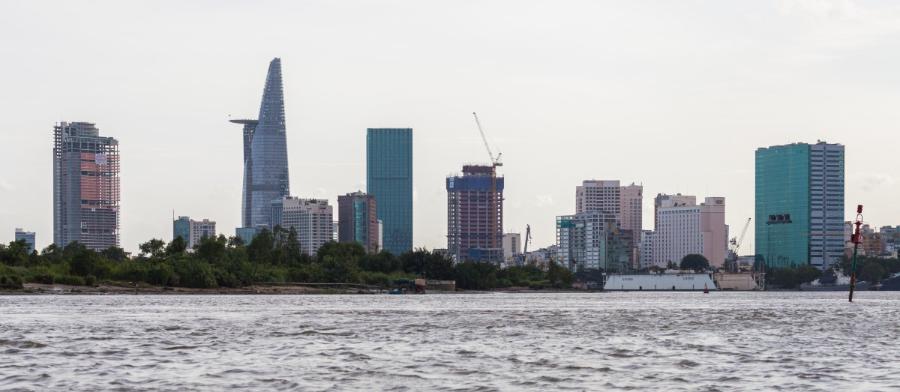Best Selling Products
How to take professional panorama photos with a DSLR camera
Nội dung
- 1. Introduction What is Panorama?
- 2. What is special about panoramic photography?
- 3. Instructions for taking panoramas on a DSLR
- 3.1. Prepare equipment and space
- 3.2. Choose location and set shooting angle
- 3.3. Adjust camera settings
- 3.4. Take photos in strips
- 4. Panorama image processing and merging
- 5. Tips for taking better panorama photos
- 6. Conclusion
Discover what a panorama is and how to take beautiful panorama photos on a DSLR with simple steps, from choosing the shooting angle to image processing techniques. Read now to have impressive photos.

In photography, "panorama" is not just a term but also a technique to create impressive photos, giving a sense of comprehensiveness and liveliness. If you own a DSLR and want to try your hand at panorama photography, this article will provide you with basic knowledge, from understanding panorama to effective shooting tips. Discover now with sadesign !
1. Introduction What is Panorama?
In photography, a panorama is a photograph with a greater aspect ratio of width to height, intended to capture a larger, more expansive view than a regular photograph. The concept is not simply a matter of stretching the photograph horizontally, but is also a technique for recreating expansive scenes such as natural landscapes, cities, or majestic architectural works.
.jpg)
You have probably seen panoramic photos in books, exhibitions or on social networks. These photos often have a special appeal, helping viewers feel the space and depth that a normal photo cannot express.
In the technology field, Panorama is also applied in photography software, virtual reality (VR) presentations, or simulation systems to bring about intuitive and vivid experiences. In addition, this concept can also be extended to other fields such as business or management, where it represents a general and comprehensive view of a specific problem or situation.
2. What is special about panoramic photography?
Taking panoramic photos is not just about using the panorama feature on your phone or camera, but a technique that requires preparation and adjustment. Panoramic photos often require sophistication in choosing the shooting angle, ensuring the right lighting, and especially the smooth combination of photos together to create a large photo. This requires the photographer to have an understanding of camera settings and post-production techniques to achieve the best results.
The highlight of this technique lies in the ability to combine multiple consecutive photos, creating a photo with a wider perspective than what the naked eye can observe. This is especially useful when shooting natural landscapes, monumental architecture or major events, where capturing the entire scene in a conventional photo becomes difficult. In addition, taking panoramic photos requires precision in image alignment and processing, while providing unique artistic opportunities for the photographer.
Advantages of panoramic photography
Spatial coverage : Panorama helps capture large scenes that cannot be captured in a conventional frame.
Create Depth in Your Photo : When taken properly, panoramas provide a dramatic sense of depth, making the viewer feel as if they are standing in the scene itself.
Creativity in photography : With panoramas, you can experiment with new and creative shooting angles, especially when shooting natural landscapes or large urban spaces.
3. Instructions for taking panoramas on a DSLR
Taking panoramas on a DSLR is not difficult if you understand the basic steps and process. Here is a detailed guide to help you create great panoramas.
.jpg)
3.1. Prepare equipment and space
To take good panoramas, you need a DSLR camera and some accessories, such as a tripod. A tripod helps you keep the camera steady while shooting and ensures that the photos overlap correctly.
DSLR : Sure, a DSLR will allow you to adjust settings manually, giving you more control over the lighting and other elements in your photo.
Tripod : Without a tripod, you will have a hard time capturing seamless images without any distortion. This is especially important when shooting panoramas, as any distortion can cause the image to look inconsistent.
Lens : Choose a wide-angle lens if possible. This will help you capture more detail in each photo.
To take panoramic photos on a DSLR, you need to carefully prepare both the equipment and the shooting space. First, make sure your camera is firmly mounted on a tripod to avoid shaking when shooting. Use a lens with a suitable focal length, usually a wide-angle lens, to achieve a comprehensive view. Next, adjust camera parameters such as aperture, shutter speed and ISO to ensure uniform lighting and sharpness. The shooting space needs to be carefully selected, prioritizing places with large landscapes and few obstacles. Pay attention to lighting conditions and avoid sudden changes in brightness in the frame so that the panorama is seamless and natural.
3.2. Choose location and set shooting angle
One of the most important factors when shooting a panorama is choosing the right angle. You need to find a location that is wide open, has few obstacles, and has depth to show off the beauty of the scene.
Choosing a location : Try to find a wide open space like a beach, hilltop, or an elevated viewpoint where you can see the whole scene.
Adjust your angle : Make sure you have a consistent angle, not too high or too low. Remember that keeping the camera steady is extremely important for perfect composite shots.
3.3. Adjust camera settings
The shooting modes on your DSLR give you control over important factors like aperture, shutter speed, and ISO. To ensure consistent panoramas, follow these steps:
.jpg)
Aperture Priority mode : Set the aperture to a moderate value, such as f/8 or f/11, so that all the details in the scene are sharp.
Low ISO : To reduce noise in your photos, choose a low ISO (100-200) if there is enough light.
Shutter speed : The shutter speed doesn't need to be too fast, but make sure the camera doesn't shake when taking the photo.
First, switch your camera to manual mode to have full control over parameters such as aperture, shutter speed and ISO. Make sure that the white balance is set to a fixed level, avoiding automatic mode to maintain color consistency between photos. Use a wide-angle lens or a suitable focal length to cover the entire scene. In addition, it is recommended to turn off the Auto Focus mode after focusing correctly to avoid changing the focus during shooting. Finally, use a tripod and panorama head to keep the camera stable and ensure the frames are aligned correctly, making it easy and effective to stitch the photos later.
3.4. Take photos in strips
To take a panorama on a DSLR, you need to follow a series of basic steps to ensure the quality and continuity of the photo. First, select Manual shooting mode to have full control over parameters such as aperture, shutter speed and ISO, avoiding changes between frames. Use a tripod to keep the camera stable and ensure a consistent shooting angle. When shooting, rotate the camera horizontally or vertically, depending on the scene you want to capture, and make sure each photo has an overlap of about 20-30% so that the photo stitching software can connect the frames smoothly. Finally, use specialized editing software to combine the photos into a complete panorama. Following these steps correctly will help you create sharp and impressive panoramas.
4. Panorama image processing and merging
Once you have taken all the photos, the next step is to stitch them together to create a complete panorama. You can use software like Adobe Lightroom or Photoshop to do this.
.jpg)
Lightroom : You can use the "Merge to Panorama" feature in Lightroom to automatically stitch photos together.
Photoshop : If you want more control, you can use Photoshop to merge photos using the “Photomerge” tool. This software will automatically align and merge the photos, but sometimes you need to edit the borders to make the photo perfect.
This process requires precision in aligning common points between photos, applying processing algorithms to eliminate deviations and ensure continuity in color and light. The final result is a high-resolution panorama photo, providing a wide angle of view and outstanding detail, often used in landscape photography, architecture or virtual reality applications. The application of specialized software and advanced technology will help optimize the process and improve product quality.
5. Tips for taking better panorama photos
To take better panorama photos, you need to pay attention to some important factors, specifically as follows:
Plan ahead : To get an impressive panorama, plan your scene, shooting time and angle.
Find good light : Good light will bring out the details in your panorama. Choose the golden hour for soft light and eye-catching effects.
Use editing software : After taking and merging photos, use editing software to increase the brightness, contrast, and details of the photo.
6. Conclusion
Taking panoramas on a DSLR is not difficult if you master the basic steps and necessary techniques. Choosing the right equipment, understanding the shooting angle, lighting and post-processing will help you create perfect panoramas. Experiment and be creative with the scenery around you, making each panorama a memorable work of art.












































